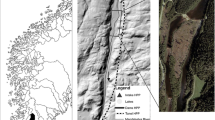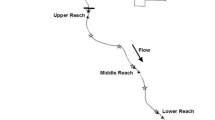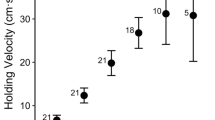Abstract
We hypothesize that foraging stream salmonids move during summer because (1) they monitor habitat conditions at a reach scale (100s of m), and (2) dominant fish move when conditions in their present foraging location become sub-optimal relative to conditions at other locations in the reach. To test these ideas, we quantified temporal variation in foraging habitat quality between late spring and early fall in a reach of a small Rocky Mountain brook charr, Salvelinus fontinalis, stream, predicted optimal-foraging fish distributions within the reach, and experimentally manipulated access to foraging sites and measured fish responses. Our results show that high-quality foraging sites were located at certain places in the reach during one period, but at different places during others, consistent with the hypothesis that fish movement is required if dominant fish are to occupy high-quality foraging sites throughout summer. The optimal foraging model was able to predict foraging locations within study pools, but not the exact location of individual fish within the pools or the reach. However, empirical evidence suggests that fish were distributed in order to maximize energy intake at the reach scale. Finally, dominant fish excluded from their preferred foraging location either left the pools (three of six cases), or began to occupy focal points of the next largest fish which, in turn, exited the pool (two of six cases). If habitat selection was occurring only within habitat units, then large fish, when excluded from their preferred locations, would select the next best locations within the pool. Taken together, these results suggest that charr use summertime movements to both monitor habitat conditions at a large spatial scale, and to gain access to optimal foraging locations even as conditions change temporally.
Similar content being viewed by others
References cited
Abbott, J.C., R.L. Dunbrack & C.D. Orr. 1985. The interaction of size and experience in dominance relationships of juvenile steelhead trout (Salmo gairdneri). Behaviour 92: 241–253.
Altmann, J. 1974. Observational study of behavior: sampling methods. Behaviour 49: 226–267.
Bachman, R.A. 1984. Foraging behavior of free-ranging wild and hatchery brown trout in a stream. Trans. Amer. Fish. Soc. 113: 1–32.
Bannon, E. & N.H. Ringler. 1986. Optimal prey size for stream resident brown trout (Salmo trutta): tests of predictive models. Can. J. Zool. 64: 704–713.
Bart, J. 1995. Acceptance criteria for using individual-based models to make management decisions. Ecol. Appl. 5: 411–420.
Bernstein, C., A.C. Kacelnik & J.R. Krebs. 1988. Individual decisions and the distribution of predators in a patchy environment II: the influence of travel costs and structure of the environment. J. Anim. Ecol. 57: 1007–1026.
Bisson, P.A. 1978. Diel food selection by two sizes of rainbow trout (Salmo gairdneri) in an experimental stream. J. Fish. Res. Board Can. 35: 971–975.
Bisson, P.A., J.L. Nielsen, R.A. Palmason & L.E. Grove. 1982. A system of naming habitat types in small streams, with examples of habitat utilization by salmonids during low stream-flow. pp. 72–73. In: N.A. Armantrout (ed.) Acquisition and Utilization of Aquatic Habitat Inventory Information, Western Division, American Fisheries Society, Bethesda.
Bridcut, E.E. & P.S. Giller. 1995. Diet variability and foraging strategies in brown trout (Salmo trutta): an analysis from subpopulations to individuals. Can. J. Fish. Aquat. Sci. 52: 2543–2552.
Bryan, J.E. & P.A. Larkin. 1972. Food specialization by individual trout. J. Fish. Res. Board Can. 29: 1615–1624.
Cada, G.F., J.M. Loar & M.J. Sale. 1987. Evidence of food limitation of rainbow and brown trout in southern Appalachian soft-water streams. Trans. Amer. Fish. Soc. 116: 692–702.
Chapman, D.W. 1962. Aggressive behavior in juvenile coho salmon as a cause of emigration. J. Fish. Res. Board Can. 19: 1047–1080.
Charnov, E.L. 1976. Optimal foraging: the marginal value theorem. Theor. Pop. Biol. 9: 129–136.
Clark, M.E. & K.A Rose. 1997. Individual-based model of stream-resident rainbow trout and brook char: model description, corroboration, and effects of sympatry and spawning season duration. Ecol. Model. 94: 157–175.
Cummins, K.W. & J.C. Wuycheck. 1971. Caloric equivalents for investigations in ecological energetics. Mitt. internat. Ver. Theor. Ang. Limnol. 18: 1–158.
Dill, L.M. & A.H.G. Fraser. 1984. Risk of predation and the feeding behavior of juvenile coho salmon (Oncorhynchus kisutch). Behav. Ecol. Sociobiol. 16: 65–71.
Dunbrack, R.L. & L.M. Dill. 1983. A model of size dependent surface feeding in a stream dwelling salmonid. pp. 41–54. In: D. Noakes, D. Linquist, G. Helfman & J. Ward (ed.) Predators and Prey in Fishes, Dr W. Junk Publishers, The Hague.
Ensign, W.E., R.J. Strange & S.E. Moore. 1990. Summer food limitation reduces brook and rainbow trout biomass in a southern Appalachian stream. Trans. Amer. Fish. Soc. 119: 894–901.
Fausch, K.D. 1984. Profitable stream positions for salmonids: relating specific growth rate to net energy gain. Can. J. Zool. 62: 441–451.
Filbert, R.B. & C.P. Hawkins. 1995. Variation in condition of rainbow trout in relation to food, temperature, and individual length in the Green River, Utah. Trans. Amer. Fish. Soc. 124: 824–835.
Giles, N. 1983. Behavorial effects of the parasite Schistocephalus solidus on an intermediate host, the three-spined stickleback, Gasterosteus aculeatus. Anim. Behav. 31: 1192–1194.
Gotceitas, V. & J.J. Godin. 1992. Effects of location of food delivery and social status on foraging-site selection by juvenile Atlantic Salmon. Env. Biol. Fish. 35: 291–300.
Gotceitas, V. & J.J. Godin. 1993. Effects of aerial and in-stream threat of predation on foraging by juvenile Atlantic salmon (Salmo salar). pp. 35–41. In: R.J. Gibson & R.E. Cutting (ed.) Production of Juvenile Atlantic Salmon, Salmo salar, in Natural Waters, Can. J. Fish. Aquat. Sci. Spec. Publ. 118.
Gowan, C. & K.D. Fausch. 1996a. Long-term demographic responses of trout populations to habitat manipulation in six Colorado streams. Ecol. Appl. 6: 931–946.
Gowan, C. & K.D. Fausch. 1996b. Mobile brook trout in two-high-elevation Colorado streams: re-evaluating the concept of restricted movement. Can. J. Fish. Aquat. Sci. 53: 1370–1381.
Gowan, C., M.K. Young, K.D. Fausch & S.C. Riley. 1994. Restricted movement in resident stream salmonids: a paradigm lost? Can. J. Fish. Aquat. Sci. 51: 2626–2637.
Grand, T.C. & J.W.A. Grant. 1994. Spatial predictability of resources and the ideal free distribution in convict cichlids, Cichlasoma nigrofasciatum. Anim. Behav. 48: 909–919.
Grant, J.W.A. & D.L.G. Noakes. 1987. Escape behavior and use of cover by young-of-the-year brook trout, Salvelinus fontinalis. Can. J. Fish. Aquat. Sci. 44: 1390–1396.
Hanski, I. 1999. Metapopulation ecology. Oxford University Press, Oxford. 313 pp.
Heggenes, J., J.L. Bagliniere & R.A. Cunjak. 1999. Spatial niche variability for young Atlantic salmon (Salmo salar) and brown trout (S. trutta) in heterogeneous streams. Ecol. Freshwat. Fish 8: 1–21.
Hill, J. & G.D. Grossman. 1993. An energetic model of microhabitat use for rainbow trout and rosyside dace. Ecology 74: 685–698.
Hughes, N.F. 1992a. Ranking of feeding positions by drift-feeding Arctic grayling (Thymallus arcticus) in dominance hierarchies. Can. J. Fish. Aquat. Sci. 49: 1994–1998.
Hughes, N.F. 1992b. Selection of positions by drift-feeding salmonids in dominance hierarchies: model and test for Arctic grayling (Thymallus arcticus) in subarctic mountain streams, interior Alaska. Can. J. Fish. Aquat. Sci. 49: 1999–2008.
Hughes, N.F. 1999. Population processes responsible for larger-fish-upstream distribution patterns of Arctic grayling (Thymallus arcticus) in interior Alaskan runoff rivers. Can. J. Fish. Aquat. Sci. 56: 2292–2299.
Hughes, N.F. 2000. Testing the ability of habitat selection theory to predict interannual movement patterns of a drift-feeding salmonid. Ecol. Freshwat. Fish 9: 4–8.
Hughes, N.F. & L.M. Dill. 1990. Position choice by drift-feeding salmonids: model and test for Arctic grayling (Thymallus arcticus) in subarctic mountain streams, interior Alaska. Can. J. Fish. Aquat. Sci. 47: 2039–2048.
Hughes, N.F. & J.B. Reynolds. 1994. Why do Arctic grayling (Thymallus arcticus) get bigger as you go upstream? Can. J. Fish. Aquat. Sci. 51: 2154–2163.
Huntingford, F.A. 1993. Can cost-benefit analysis explain fish distribution patterns? J. Fish Biol. 43: 289–308.
Jenkins, T.M. 1969. Social structure, position choice and microdistribution of two trout species (Salmo trutta and Salmo gairdneri) resident in mountain streams. Anim. Behav. Monogr. 2: 56–123.
Jowett, I.G. 1992. Models of abundance of large brown trout in NewZealand rivers. NorthAmer. J. Fish. Manage. 12: 417–432.
Juanes, F., B.H. Letcher & G. Gries. 2000. Ecology of stream fish: insights gained from an individual-based approach to juvenile Atlantic salmon. Ecol. Freshwat. Fish 9: 65–73.
Kalleberg, H. 1958. Observations in a stream tank of territoriality and competition in juvenile salmon and trout (Salmo salar L. and S. trutta L.). Inst. Fresh. Res. Drott. Rep. 39: 55–98.
Magnuson, J.J., L.B. Crowder & P.A. Medrick. 1979. Temperature as an ecological resource. Amer. Zool. 19: 331–334.
Mason, J.C. & D.W. Chapman. 1965. Significance of early emergence, environmental rearing capacity and behavioral ecology of juvenile coho salmon in stream channels. J. Fish. Res. Board Can. 22: 173–190.
McNicol, R.E. & D.L.G. Noakes. 1981. Territories and territorial defense in juvenile brook charr, Salvelinus fontinalis (Pisces, Salmonidae). Can. J. Zool. 59: 22–28.
Mesick, C.F. 1988. Effects of food and cover on numbers of Apache and brown trout establishing residency in artificial stream channels. Trans. Amer. Fish. Soc. 117: 421–431.
Milinski, M. 1984. Competitive resource sharing: an experimental test of a learning role for an ESS. Anim. Behav. 32: 233–242.
Nakano, S. 1994. Variation in agonistic encounters in a dominance hierarchy of freely interacting red-spotted masu salmon (Oncorhynchus masou ishikawai). Ecol. Fresh. Fish 3: 153–158.
Nakano, S. 1995. Individual differences in resource use, growth and emigration under the influence of a dominance hierarchy in fluvial red-spotted masu salmon in a natural habitat. J. Anim. Ecol. 64: 75–84.
Noakes, D.L.G. 1980. Social behavior and interspecific competition in two trout species. Physiol. Zool. 29: 64–81.
Petty, J.T. & G.D. Grossman. 1996. Patch selection by mottled sculpin (Pisces: Cottidae) in a southern Appalachian stream. Fresh. Biol. 35: 261–276.
Railsback, S.F., R.H. Lamberson, B.C. Harvey & W.E. Duffy. 1999. Movement rules for individual-based models of stream fish. Ecol. Model. 123: 73–89.
Resh, V.H., A.V. Brown, A.P. Covich, M.E. Gurtz, H.W. Li, G.W. Minshall, S.R. Reice, A.L. Sheldon, J.B. Wallace & R. Wissmar. 1988. The role of disturbance in stream ecology. Journal of the North American Benthological Society 7: 433–455.
Riley, S.C. & K.D. Fausch. 1992. Underestimation of trout population size by maximum likelihood removal estimates in small streams. North. Amer. J. Fish. Manage. 12: 786–766.
Riley, S.C. & K.D. Fausch. 1995. Trout population response to habitat manipulation in six northern Colorado streams. Can. J. Fish. Aquat. Sci. 52: 34–53.
Riley, S.C., K.D. Fausch & C. Gowan. 1992. Movement of brook trout (Salvelinus fontinalis) in four small subalpine streams in northern Colorado. Ecol. Fresh. Fish 1: 112–122.
Ringler, N.H. 1979. Selective predation by drift-feeding brown trout Salmo trutta. J. Fish. Res. Board Can. 36: 392–403.
Rogers, L.E., W.T. Hinds & R.L. Buschbom. 1976. A general weight vs. length relationship for insects. Annals Entomol. Soc. Am. 69: 387–389.
Schlosser, I.J. 1995. Critical landscape attributes that influence fish population dynamics in headwater streams. Hydrobiologia 303: 71–81.
Schlosser, I.J. & P.L. Angermeier. 1995. Spatial variation in demographic processes in lotic fishes: conceptual models, empirical evidence, and implications for conservation. American Fisheries Society Symposium 17: 360–370.
Skalski, G.T. & J.F. Gilliam. 2000. Modeling diffusive spread in a heterogeneous population: a movement study with stream fish. Ecology 81: 1685–1700.
Smithson, E.B. & C.E. Johnston. 1999. Movement patterns of stream fishes in a Ouachita Highlands stream: an examination of the restricted movement paradigm. Trans. Amer. Fish. Soc. 128: 847–853.
Stewart, D.J. 1980. Salmonid predators and their forage base in Lake Michigan: a bioenergetics-modelling synthesis. Ph.D. Thesis, University of Wisconsin, Madison. 225 pp.
Tyler, J.A. & J.F. Gilliam. 1995. Ideal free distributions of stream fish: a model and test with minnows, Rhinichthys atratulus. Ecology 76: 580–592.
Tyler, J.A. & K.A. Rose. 1994. Individual variability and spatial heterogeneity in fish population models. Rev. Fish Biol. Fish. 4: 91–123.
Van Winkle, W., H.I. Jager, S.F. Railsback, B.D. Holcomb, T.K. Studley & J.E. Baldridge. 1998. Individual-based model for sympatric populations of brown and rainbow trout for instream flow assessment: model description and calibration. Ecol. Model. 110: 175–207.
VanWinkle, W., K.A. Rose & R.C. Chambers. 1993. Individual-based approach to fish population dynamics: an overview. Trans. Amer. Fish. Soc. 122: 397–403.
Warren, C.E., J.H. Wales, G.E. Davis & P. Doudoroff. 1964. Trout production in an experimental stream enriched with sucrose. J. Wildl. Manag. 28: 617–660.
Werner, E.E., J.F. Gilliam, D.J. Hall & G.G. Mittlebach. 1983. An experimental test of the effect of predation risk on habitat use in fish. Ecology 64: 1540–1548.
Wiens, J.A. 1986. Spatial scale and temporal variation in studies of shrubsteppe birds. pp. 154–172. In: J. Diamond & T.J. Case (ed.) Community Ecology, Harper & Row, New York.
Wildhaber, M.L. & L.B. Crowder. 1990. Testing a bioenergetics-based habitat choice model: bluegill (Lepomis macrochirus) responses to food availability and temperature. Can. J. Fish. Aquat. Sci. 47: 1664–1671.
Young, M.K., K.A. Meyer, D.J. Isaak & R.A. Wilkison. 1998. Habitat selection and movement by individual cutthroat trout in the absence of competitors. J. Freshwat. Ecol. 13: 371–382.
Author information
Authors and Affiliations
Rights and permissions
About this article
Cite this article
Gowan, C., Fausch, K.D. Why do Foraging Stream Salmonids Move During Summer?. Environmental Biology of Fishes 64, 139–153 (2002). https://doi.org/10.1023/A:1016010723609
Issue Date:
DOI: https://doi.org/10.1023/A:1016010723609




